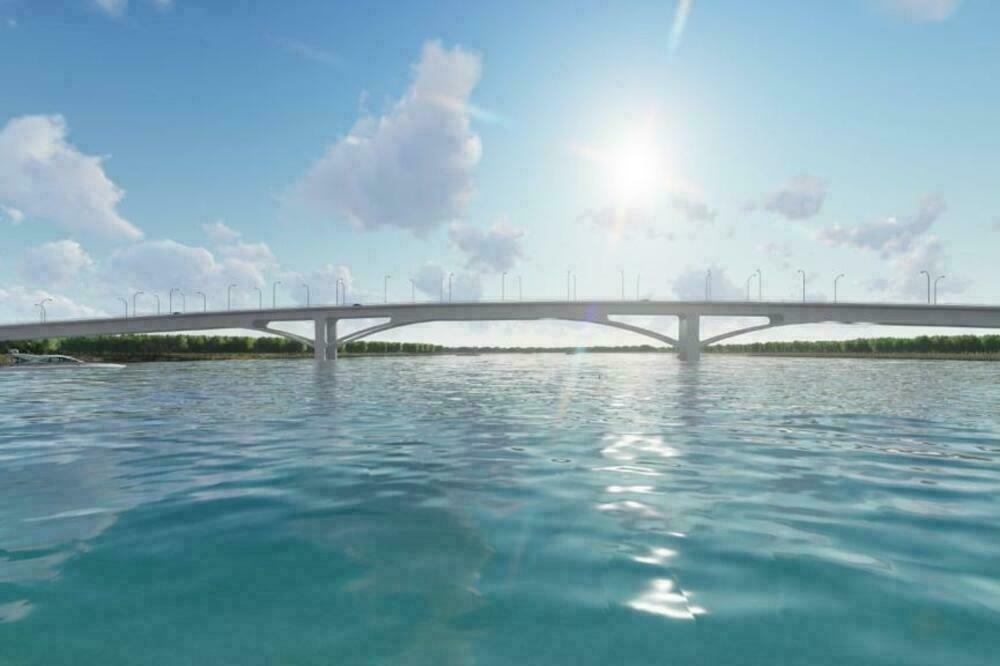The construction of the bridge on the Bojana could significantly disrupt the current ecological conditions in the wider zone of the mouth of that river.
This apprehension was expressed at the recently held Round Table "Bridge on the Bojana River - ecological challenge", which was organized by the NGO Green Home in Ulcinj, according to an expert in hydraulics, hydrology and coastal processes prof. Dr. Sava Petković from the Faculty of Agriculture, University of Belgrade.
He reminded that this zone, which is mostly located on the territory of Montenegro, is called in professional literature one of the most important natural wetlands in the Eastern Mediterranean.
"Therefore, it is paradoxical that the preparation of the project documentation is left to the Albanian side because they will be limited only to the bridge project. What about the ecological problems on the Montenegrin side of the Bojana estuary? Costs are split in half, so the Albanian side will probably reduce investigative and study work to the necessary minimum. It is unclear why no Montenegrin institution was involved in the preparation of the documentation, that is, the design, which would, among other things, take care of specific environmental problems on the territory of Montenegro," said Petković to "Vijesta".

He assessed that, given that it is a complex bridge project, it would be logical to involve at least the Faculty of Civil Engineering in Podgorica in the preparation of the project documentation.
The construction of the bridge will not begin before the adoption of the Spatial Plan, because the bridge is counted among infrastructure projects and must be recognized as such in that strategic document, it was confirmed earlier by "News" in the Ministry of Capital Investments...
Floods and climate change
He emphasized that regardless of possible environmental problems, it should also be noted that the project would have to include detailed hydraulic calculations of the water level along Bojana, under the most unfavorable conditions, including climate changes. He also states that without a detailed analysis of the available data on the morphological changes of the bridge's profile, that is, the Bojana river bed, it makes no sense to design a bridge on pillars in the river bed.
"According to the available data, the left bank of the Bojana River, on the Albanian side, is well protected from floods by built embankments. However, the coast of the right bank of Bojana, on the Montenegrin side, was flooded on several occasions in the last twenty years. The floods at the end of 2009 and the beginning of 2010 were the biggest after the catastrophic floods of January 1963, when the level of Lake Skadar reached the maximum recorded water level of 9,86 meters," Petković reminded why the Bojana bridge project would have to include detailed hydraulic calculations of the water level along Bojana.
He assessed that such calculations cannot be carried out without detailed recording of the cross profiles of Bojana along its entire course. "Such recordings were last made in 1965, after the thawing of political relations between the then Yugoslavia and Albania," he said.
It is indicative, he added, that according to the conceptual solution, the future bridge rests on two pillars in the river bed.
"It is extremely problematic if you consider the problem of erosion around bridge piers. Namely, the future bridge will be founded on two pillars in the riverbed, which is composed of thick deposits of sand. All available data from the last hundred years indicate that the profile of the bridge is subject to extremely large changes. Without a detailed analysis of the available data on the morphological changes in the profile of the bridge and the Bojana river bed, there is no point in designing a bridge on pillars in the river bed".
Important habitat
At the round table, which was held on Wednesday in the Old Town in Ulcinj, expert presentations on the topics of planning frameworks and ecological challenges of the construction of the bridge on Bojana were given by Dina Skarep from the team for the preparation of the Strategic Environmental Impact Assessment for the Spatial Plan of Montenegro, the manager of the preparation Spatial-Urban Plan Ulcinj Ksenija Vukmanović, expert-biologist Bogić Gligorović and project coordinator of NGO Green Home Nina Mihailović.
Mihailović then presented the Case Study "Construction of the bridge on Bojana", which was created by the NGO Green Home. The study points out that the Bojane Delta is an International area of importance for birds, an International area of importance for plants, an important ichthyological habitat that connects Lake Skadar and the Adriatic Sea, an important migration route and the most significant natural or semi-natural wetland in the Eastern Mediterranean.
The construction of the bridge, it is further stated, was mentioned for the first time during the presentation of the then Prime Minister of Montenegro and the current Prime Minister of Albania, Dritan Abazović and Edi Rama, during the "Open Balkans" Summit in Ohrid.
The development of the project for the construction of the bridge was financed by the Albanian side, through the Albanian Development Fund.
The bilateral agreement between Montenegro and Albania on the construction of a bridge on the Bojana River was adopted by the Government on February 24, 2023.
In the study, it is written that according to the latest information, the planned budget of the project is 20 million euros, although earlier reports were that the budget is 9 million euros, and it is planned to be borne by both states.
According to the draft of the project, the planned bridge will be 310 meters long, about 10 meters high, and will connect Velika plaža and Velipoje, which is intended to shorten the road from the current 70 to a few kilometers.
Sustainable development of tourism and economic profit
In order to achieve this, it is stated in the study, it is planned to install concrete piers for the bridge in the riverbed of Bojana, not far from its confluence with the Adriatic Sea.
"Apart from the presentation of the project idea for the bridge on Bojana/Buna, project documentation is still not available for this project, nor are there a series of studies and impact assessments that are necessary due to the specificity and importance of the area where construction is planned," the study states.
It is emphasized that for now there is no available information on how the goals of promoting sustainable tourism development in the region will be achieved, given that the bridge construction project carries potential risks of negative environmental impacts, since it is an extremely specific area of multiple importance.
"A particularly worrying circumstance is the facilitation of the procedures for the implementation of the project. As a Detailed Site Study and a Strategic Environmental Impact Assessment have not yet been prepared for this project, one gets the impression that the priorities of this project are not the sustainable development of tourism, but possible economic profit," the study says.
At the Round Table, it was concluded, among other things, that for the bridge construction project it is necessary to provide the necessary planning documentation and conduct research and studies related to the project's impact on the environment.
"Also, it is necessary to provide an Environmental Management Plan as a detailed document specifying actions, responsibilities, resources and timelines for implementing mitigation measures and monitoring impacts. For the project in question, it is appropriate to do a Life Cycle Analysis (LCA), which is a systematic method that quantifies the impact of products or services on the environment during its entire life cycle," it says, among other things, in the conclusions and recommendations.
Global Center for Biodiversity
Biologist Bogić Gligorović stated in his professional presentation "The Bojana River and Ulcinj Ecosystem Complex" that the area of the lower Bojana River basin is exceptionally rich in biodiversity, thanks to the presence of different types of habitats.
"On the site of the planned bridge and the immediate surroundings, researches of a limited scope have been carried out so far, focused on certain groups of organisms. Based on the available data, the presence of 1.653 taxa of flora and fauna has been confirmed in this area," Bogićević said.
In the area covered by the study, he added, the presence of 37 plant species of conservation importance was recorded - 25 species are protected by national legislation, two are on Annexes II and IV of the EU Habitat Directive, two are on Annex I of the Berne Convention, and 14 species are endemic or subendemic.
18 habitat types from the EU Habitat Directive have been identified in the vicinity of the area.
"The presence of 378 taxa of fauna - 21 molluscs, 8 arthropods, 6 crustaceans, 203 insects, 27 fish, 12 amphibians, 19 reptiles, 62 birds and 20 mammals was recorded in the area. Of the species present, 37 were identified as significant. There are 208 species of conservation importance on the site and in the immediate vicinity - 37 plants, 9 molluscs, 1 arthropod, 38 insects, 10 fish, 12 amphibians, 19 reptiles, 62 birds and 19 mammals. 18 habitat types from the EU habitat directive have been identified in the area. The area is extremely important in terms of biodiversity and conservation, and is one of the global centers of biodiversity," says Bogićević's analysis.
Bonus video:





